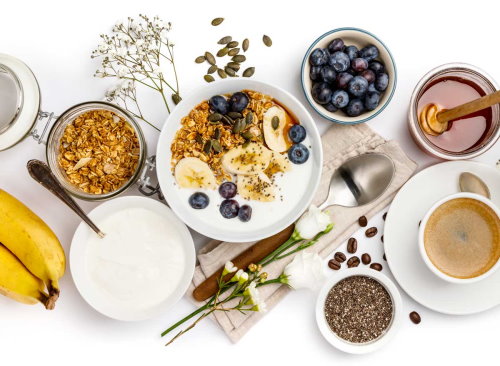Whether you know it or not, carbohydrates are essential for life. Your brain and nervous system demand a continuous supply of glucose to function properly. When dietary carbohydrate intake is too low (for too long), metabolic rate and thyroid hormones can suffer. In addition, the body may break down lean muscle tissue to supply glucose to the brain.
According to the American Dietetic Association, a minimum recommended intake for carbohydrate consumption has been set at 130 grams per day to meet basic energy requirements and optimal brain functioning. However, carbohydrate type, timing, amount, body size and composition, activity levels, and specific goals all play notable roles in food selection.
BREAKING: Shed 42 lbs In 30 Days With This Simple Night-time Pill
What is a Controlled-Carbohydrate Diet?
Regardless of your goals, carbohydrate intake should match activity levels. Most people will do better by reducing carbohydrate intake, but it doesn’t mean that a low-carb diet is necessary. Rather, a controlled-carbohydrate diet seems to work well.
To determine the right amount of carbohydrates for you and your lifestyle, start by figuring out how many calories you need.
Precision Nutrition has a simple guideline that’s a good place to start:
- Fat Loss: 0.8 + 0.1 per hour of intense exercise performed per week x bodyweight
- Weight Maintenance/Body Recomposition: 1.0 + 0.1 per hour of intense exercise performed per week x bodyweight
Let’s use a 175-pound individual who exercises intensely 2 hours per week as an example.
- Fat Loss: (0.8 + 0.2) = 1 x 175 = 175 grams of carbohydrates
- Weight Maintenance/Body Recomposition: (1.0 + 0.2) = 1.2 x 175 = 210 grams of carbohydrates
Understanding Glycemic Index
You may be familiar with the classic carbohydrate debate of complex vs. simple, but there’s another way to classify carbs.
You see, all carbohydrates—both complex and simple—are broken down into sugars in the body. The rate of digestion and absorption, however, can make a big difference.
It ultimately comes down to the glycemic index (GI), which is a measurement of how quickly and how much a carbohydrate elevates blood sugar. Higher GI foods (think refined sugar, white breads, cereals), cause a rapid spike in blood sugar. Foods on the other end of the spectrum (like legumes, nuts, and vegetables) provide a slower, more sustained release of blood sugar.
In addition, it’s a good idea to understand another scale: the glycemic load. This is a more realistic measurement as it also looks at serving sizes. For reference, here are some numbers to help guide you:

The following foods are our good carbs for weight loss as well as overall health and wellness.
10 Good Carbs for Weight Loss
#10: Brown Rice
Brown rice, which has more fiber, minerals, and nutrients than its “stripped” white counterpart, scores as low as 48 on the GI scale. Wild rice, also known as Canadian rice, Indian rice, or water oats, is technically a grass, which makes it a reasonable source of omega-3 fatty acids. Combinations of wild and brown rice score even lower on the GI (45).
Choose brown or wild rice (or a combination) instead of white rice, which scores as high as 89 on the GI scale. Try adding some slices of lean meat and freshly steamed or sautéed vegetables to further slow the release of blood sugar.
#9: Sweet Potatoes
This wonderful orange-colored tuber is considered a root vegetable. It is packed with fiber, beta-carotene, vitamin C, vitamin B6, manganese, and potassium. This naturally sweet, starchy vegetable scores low on the GI (46) and moderately on the GL (11) when boiled with its skin. Interestingly, when baked, the GI and GL jump (e.g., 94 and 42, respectively), likely due to the modification of the starches during the cooking process.
Boiled sweet potatoes and new potatoes, which score low on the GI (49) and moderately on the GL (15), can be a great addition to a nice piece of baked fish or grilled meat after a workout.
#8: Sprouted Grain Bread
Sprouted grain breads, like Ezekiel 4:9 bread made by Food for Life®, which is one of the most popular sprouted grain breads, is a good carb for weight loss AND a wonderful way to include bread in your diet without all the issues associated with white breads and even 100% whole-wheat breads.
While white bread scores a whopping 100 on the GI scale, sprouted grains are not nearly as processed as the stripped flours used in the majority of flour-based breads you’ll find lining the store shelves. In addition, sprouted grains are far more easily digested in the human body than commercial wheat.
This process, which is similar to fermentation, reduces the amount the phytic acid content of the grains. Phytic acid is considered an anti-nutrient because it can reduce the absorption of vitamins, minerals, and phytonutrients, as well as inhibit enzymes that are necessary for digestion.
Ezekiel bread is organic, sprouted, 100% whole-grain flourless bread. A two-slice serving also contains 8 grams of complete protein and 6 grams of fiber. You don’t give up the bread—just choose the right kind. Products—including breads, cereals, wraps, and more—that have been certified as Low Glycemic by The Glycemic Research Institute.
#7: Sprouted Grain and Spelt Pasta
Piggy-backing on sprouted grain breads are pasta varieties like sprouted grain pasta, spelt pasta, and rice pasta. While the GI for most pastas is actually relatively moderate (between 50 and 60), the standard white pasta offers little nutritional value compared to these less processed and more gut-friendly varieties.
Spelt is an “ancient grain” that’s an excellent source of manganese and a good source of fiber, protein, copper, and zinc. Although it is considered a distant cousin to wheat, spelt does not seem to cause sensitivities in most people who are intolerant of wheat. Spelt ranks on the low end of the GI scale (45) making it a good carb for weight loss.
If you love pasta, don’t think that you have to give it up to lose belly fat. Rather, make the switch to a low-glycemic sprouted grain or spelt pasta. Bon appétit!
#6: Oatmeal
Oatmeal is another one of those foods that has progressively seen its demise as a health food because of processing and added sugars. Many of the store-bought varieties are instant oatmeal. They are typically packed with artificial ingredients, colors, and flavors. What’s more, they are also rife with regular sugar.
TRENDING: This Keeps Your Blood Sugar Below 100 - Even When You're Eating Sweets!
Many include flavoring gel packets, which are full of high fructose corn syrup or sugar. Talk about royally screwing up oatmeal! Instant oatmeal typically has a significantly higher GI score than old-fashioned oatmeal due to its instant nature where it’s been pre-cooked via high-heat processing. This high-heat processing also robs the oatmeal of many important vitamins and minerals, making it an overall less nutritious product.
So, if you’re going to go with oatmeal, please stay away from the instant, processed, sugar-laden versions. Instead, the best choice is steel-cut oats, which score 42 on the GI scale. While they take a few extra minutes to cook (and eat), it’s certainly worth it for the lower glycemic index, extra fiber, and higher vitamin and mineral content.
Steel-cut oats will also leave you feeling fuller, longer, and you’ll probably find that you enjoy the firmer texture and nuttier flavor a LOT more than mushy instant oatmeal. Alternatively, you can choose regular old-fashioned oats, which are also low on the GI scale (50).
#5: Oranges
This juicy citrus fruit is low in calories and carbohydrates yet chockful of fiber, vitamin C, and various phytonutrients and antioxidants. Oranges rank incredibly low on the GI scale (40), and their vitamins and phytonutrients may provide additional benefits outside of reduced belly fat.
In one study, German researchers found that consuming vitamin C helped test subjects experience reduced elevations in cortisol (your body’s #1 stress hormone) and blood pressure when subjected to a specific stressful environment: public speaking and math problems. (Gotta feel bad for the poor research subjects!) Oranges, of course, are known for their high vitamin C content. Other foods high in vitamin C include peppers, cantaloupe, and tomatoes, just to name a few.
A word of caution: steer clear of store-bought orange juice. Despite what the labels may have you believe, most of these are heavily processed with added sugars and a far cry from the lovely fruit that was once an orange.
#4: Quinoa
While it has a similar taste, texture, and mouthfeel to a grain, quinoa is a gluten-free seed, which contains double the protein of brown rice along with greater fiber content and a lower glycemic load. Not only that, but quinoa is the ONLY grain-like food to contain complete protein and the full spectrum of amino acids. It comes in several varieties, including “oatmeal-like” flakes and its whole-grain rice-like form.
This “ancient grain” is low GI (53) and moderate GL (13). Quinoa has a unique, nutty taste and chewy texture. It is also high in B vitamins, iron, calcium, and magnesium, making it a true nutrient-dense all-star. Enjoy it as an oatmeal substitute for breakfast, in salads or casseroles, or as a wholesome whole-grain, high-protein side for any healthy lunch or dinner.
#3: Berries & Cherries
Berries like blueberries, blackberries, strawberries, raspberries, and cherries (although not technically a berry) are some of the BEST carbohydrates you can eat. They are high in fiber, packed with antioxidants, and score extremely low on the glycemic index, especially cherries which come with a GI of just 22.
The GL for these fruits range from 1 – 5, making them an ideal carb for weight loss and burning belly fat. You can add them to smoothies, eat them by themselves, or make a Greek yogurt parfait.
BREAKING: 1 Cup of This Melts Belly and Arm Fat (Take Before Bed)
#2: Green Vegetables
You would be hard-pressed to over-consume vegetables, and the good news is that nearly all vegetables rank on the low end of the GI scale. This is one reason why we consider them “free” and don’t place any limitations on timing or amounts.
Spinach, cucumbers, broccoli, Brussel sprouts, green beans, and varieties of lettuce all fit in this category. But, you’re not limited to these, as cauliflower, bell peppers, onions, mushrooms, cabbage, zucchini, eggplant, tomatoes, carrots, and more are all bursting with fiber, vitamins, minerals, phytonutrients, and antioxidants while being very low in carbohydrates and calories.
What’s more, consuming veggies with each meal provides much-needed micronutrients that can help you balance out your body’s acidity. It’s important to balance out the body’s acidity (e.g., pH) for multiple reasons. If the body’s pH is not balanced, it can lead to the following negative health consequences:
- Decreased growth factors
- Growth hormone resistance
- Mild hypothyroidism
- Higher levels of blood cortisol
- Loss of muscle mass
- Enzymatic changes in the cell
- Altered regulation of metabolites and minerals
- Decreased uptake and release of oxygen
Veggies are high in fiber, which can also positively impact satiety. As a matter of fact, fiber can stimulate special cells within the GI tract to secrete hormones that communicate satiety to the brain.
Consider veggies to be free foods, and we suggest consuming two or more servings with each meal. A serving of chopped raw vegetables is equivalent to a half-cup (about a palmful), while a serving of leafy vegetables is one cup (roughly one packed handful).
#1: Beans & Lentils
Beans and lentils, part of the “legume” family, are top carbs for weight loss options. Packed with loads of fiber and protein, they come in so many different varieties that you’ll never get bored: lentils, chickpeas, black-eyed peas, black beans, red beans, kidney beans, navy beans, butter beans, lima beans, pinto beans… and the list goes on.
Although the varieties are endless, beans as a whole score incredibly low on the GI scale (10 – 50) and GL (3 – 15), which make them excellent carbohydrate options. Certain beans, like navy beans, and lentils are high in a fat-fighting ingredient called resistant starch.
Resistant starch is known as a third type of fiber, possessing numerous health and weight-management properties. Resistant starch is low calorie and low glycemic, and has been shown to increase insulin sensitivity in healthy individuals. Resistant starch also encourages the growth of healthy bacteria in the bowel, making it known as a “prebiotic fiber” that soothes the intestinal tract and aids in promoting regularity.
Top 10 Good Carbs For Weight Loss
Carbohydrate foods aren’t just important, they’re needed for optimal functioning, to provide energy, and to supply vital nutrients. Plus, many of them are delicious. At the end of the day, it’s important to pair the types of carbohydrates you eat with your activity levels. For the most part, stick with those that are slow-digesting, unprocessed, and high in fiber to help support your weight-loss efforts.









